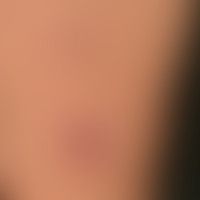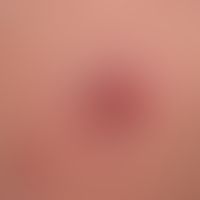Image diagnoses for "red"
877 results with 4457 images
Results forred

Atrophy of the skin (overview)
Atrophy of the skin due to many years of internal use of glucocorticoids. Bizarre scars due to tearing of the skin after banal abrasions.

Dermatitis herpetiformis L13.0
Dermatitis herpetiformis. multiple, disseminated standing, itchy, scratched excoriations on the right arm of a 15-year-old patient. the scratched excoriations are located at sites where grouped vesicles had appeared a few days before. overall, the disease has existed for several months and shows a chronically recurrent course.

Granuloma anulare disseminatum L92.0

Zoster in the trigeminal region B02.8

Tinea inguinalis B35.6
Tinea inguinalis: plaques that have existed for several months, coarse lamellar scaling and moderately itchy. Mycological evidence of T. rubrum.

Acroangiodermatitis I87.2
Acroangiodermatitis. detail from the above figure. 0.2-0.4 cm large, initially isolated, then aggregated, deep red to reddish-livid papules develop from the smallest red (haemorrhagic) spots with a smooth surface, which finally confluent to form large plaques.

Crohn disease, skin alterations K50.9
Enteritis regionalis, skin lesions, chronic, acneiform, follicular and parafollicular, in places abscessing inflammatory reactions on lower abdomen and thighs. 42-year-old woman with enteritis regionalis. Further findings: Striae cutis after pregnancy.

Dyskeratosis follicularis Q82.8
Dyskeratosis follicularis. infestation of the Rima ani. chronic, intertriginous, whitish sooty, blurred, macerated, superficially rough, clearly increased in consistency, itchy and unpleasant smelling plaques. peripherally the characteristic picture of dyskeratosis follicularis with disseminated red or red-brown papules. on the left side 2 melanocytic nevi.

Mycosis fungoides C84.0
Special form: Mycosis fungoides, folliculotropic. 3-year-old clinical picture with strongly itchy, moderately sharply defined, follicular red plaques. secondary findings: multiple melanocytic nevi.

Vasculitis leukocytoclastic (non-iga-associated) D69.0; M31.0
Vasculitis, leukocytoclastic (non-IgA-associated). multiple, acute, symmetric, since 2 weeks existing, localized on both lower legs, irregularly distributed, 0.1-0.2 cm large, sharply defined, symptomless, hemorrhagic spots and blisters as well as beginning incrustations.

Larva migrans B76.9
Larva migrans. linear plaque, subepidermally situated, tortuous, constantly itching gait on the right hollow foot. conspicuously in the area of the gait structures described blister formation.

Sarcoidosis of the skin D86.3
Sarcoidosis, subcutaneous nodular form:known pulmonary sarcoidosis; skin findings: subcutaneously and cutaneously located nodules and plates which can be easily distinguished from the surrounding area and which slide on the support.

Lymphomatoids papulose C86.6
Lymphomatoid papulosis: Patient, 73 years of age. Within a few days a red, solid nodule appeared on the nasal wing. In the biopsy atypical dermal infiltrates with CD30-positive blasts. Within a few more days multiple similar nodules spread over the upper trunk.
At control 8 weeks after initial diagnosis the nodule at the nasal fossa is completely regressive leaving a milieu, but a new nodule 5 mm further cranially. The nodules at the trunk are regressive.

Glossitis rhombica mediana K14.2

Herpes simplex recidivans B00.8
Herpes simplex recidivans: in loco recurrent herpes simplex. Fig.from Eiko E. Petersen, Colour Atlas of Vulva Diseases. with permission of Kaymogyn GmbH Freiburg.5.040_Herpes glutäaliscopy2.jpg

Ulerythema ophryogenes L66.4
Ulerythema ophryogenes. extensive erythema with (scarred) raeration of the eyebrows. symmetrical pattern of infection.








